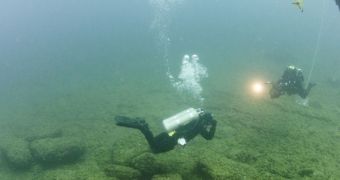Experts may soon know more about a period of North American prehistory that has been left relatively obscured for a very long time. The new data could be derived from an 8,900-year-old piece of wood, which was found at the bottom of Lake Huron.
The pole-shaped piece is about 5.5 feet (1.67 meters) long, and appears to have been tapered in a deliberate manner. Scientists at the University of Michigan suggest that the wood may have been modified by humans living on the lake's shores at the time.
“This was the stage when humans gradually shifted from hunting large mammals like mastodon and caribou to fishing, gathering and agriculture,” anthropologist John O'Shea says, explaining that this shift is very important for understanding North American prehistory.
However, studying it is extremely difficult, since the lands on which it took place are now submerged. With this in mind, the U-M team is hoping to use the new shard to figure out what happened during this critical historic moment.

 14 DAY TRIAL //
14 DAY TRIAL //